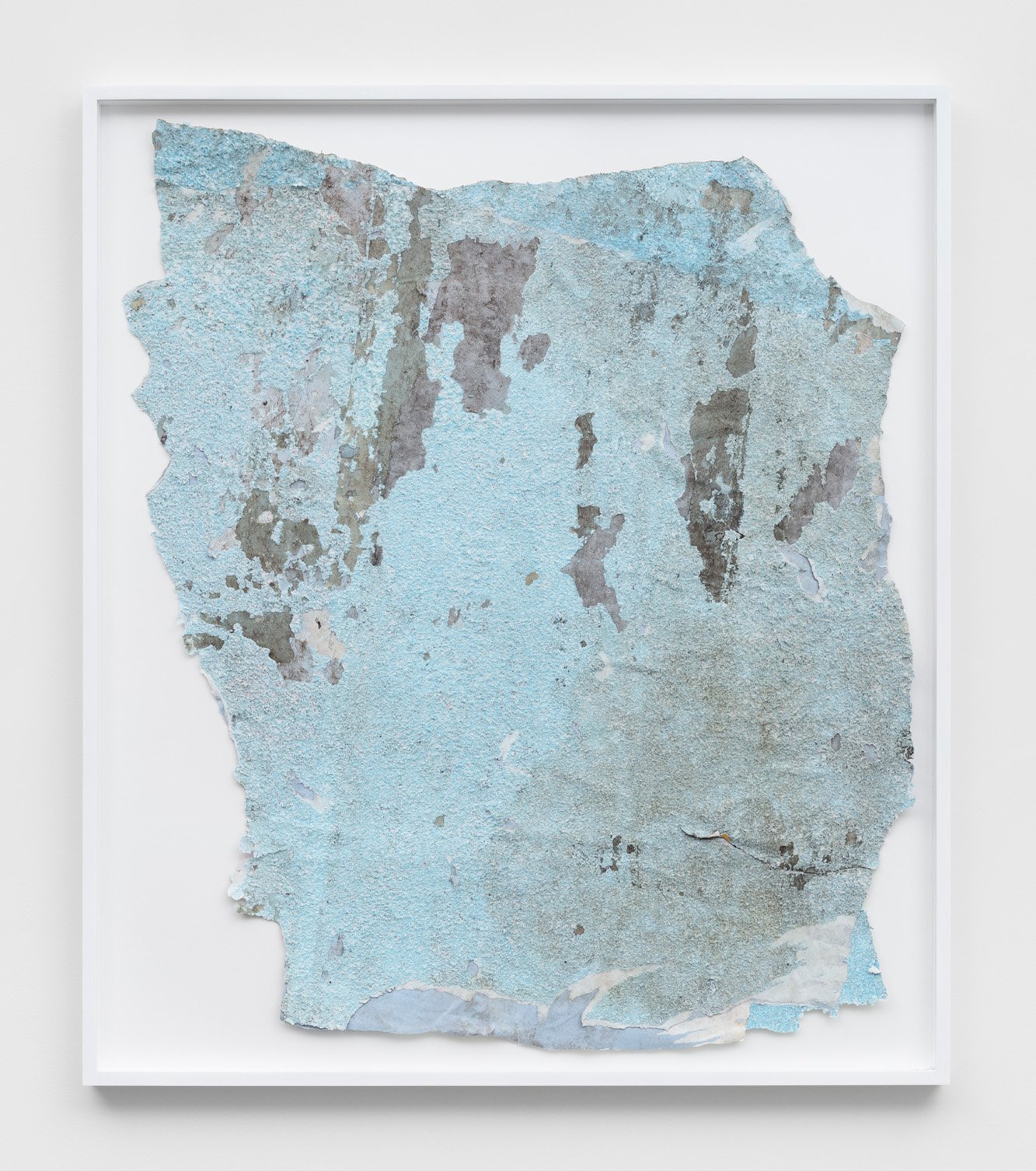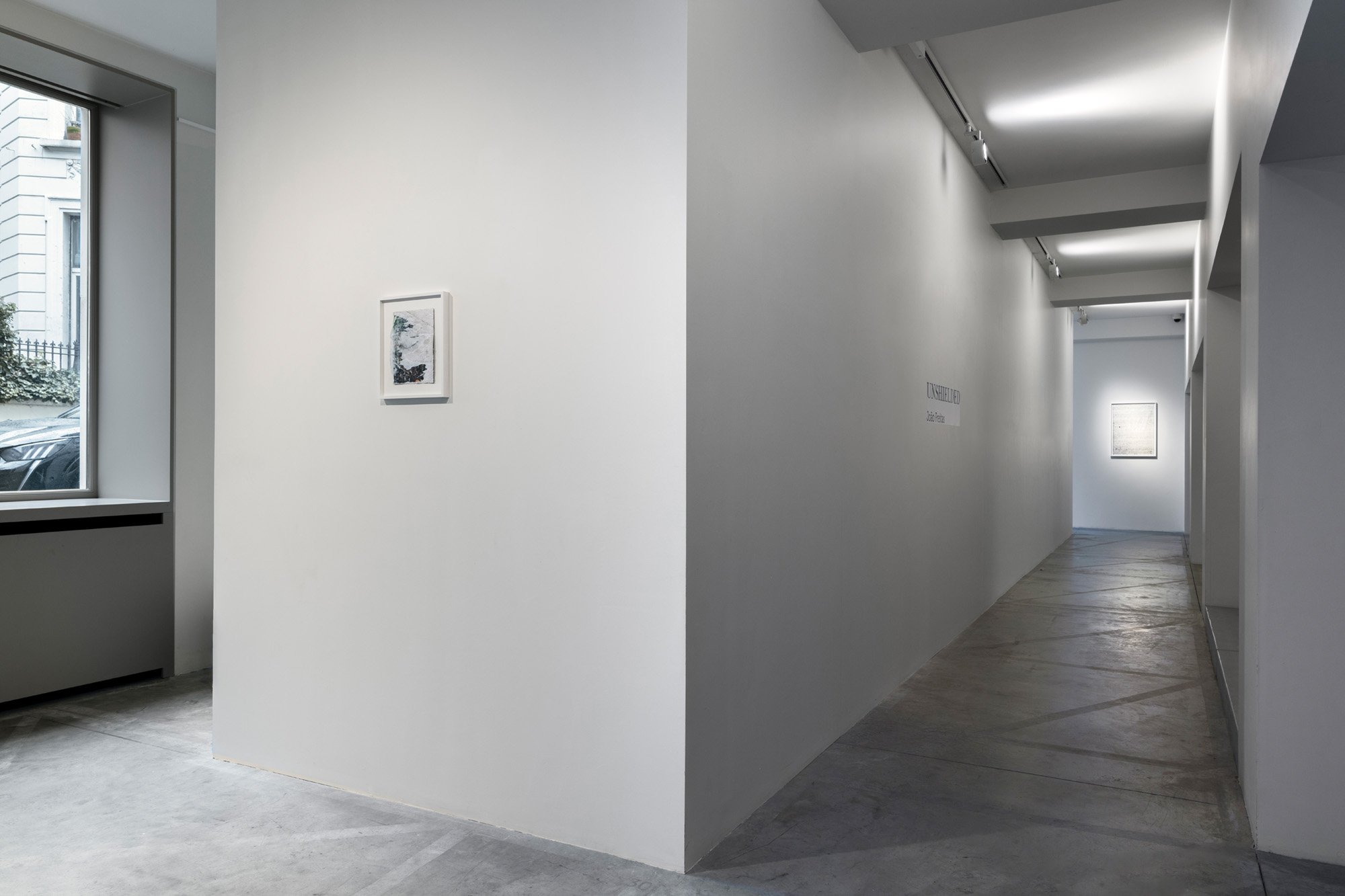Unshielded, 15.01 - 26.03.2022
La Patinoire Royale - Galerie Valérie Bach, Brussels, Belgium
Exhibition view, Unshielded, 15.01 - 26.03.2022, La Patinoire Royale - Galerie Valérie Bach, Brussels, Belgium | © Gilles Ribero, REGULAR STUDIO
Untitled (Brandis), 2021 — Found book cover, rain (scratched) — 36 x 30 cm
Untitled (Contract), 2021 — Paper (scratched) — 39,5 x 31,5 cm
Untitled (Invoice), 2021 — Paper (scratched) — 39,5 x 31,5 cm
Untitled, 2021 — Found poster, rain (torn, scratched) — 76 x 67 cm
Untitled, 2021 — Found poster, rain (torn, scratched) — 107,5 x 99,5 cm
Untitled, 2021 — Found poster, rain (torn, scratched) — 100 x 82,5 cm
Untitled, 2021 — Found poster, rain (torn, scratched) — 130 x 95 cm
Untitled, 2021 — Found poster, rain (torn, scratched) — 107,5 x 88 cm
Untitled, 2020 — Found poster, rain (torn, scratched) — 106,5 x 92,5 cm
Untitled (Berlin), 2021 — Magazine cover (scratched) — 52,5 x 37,5 cm
Untitled, 2021 — Found paper (scratched) — 39,5 x 31,5 cm
Untitled, 2021 — Abrasive cloth (stripped) — 67,5 x 53,5 cm
Untitled, 2019 — Abrasive cloth (stripped) — 33 x 26 cm
Untitled, 2021 — Anti-slip protective fleece (peeled) — 86 x 65 cm
Untitled, 2021 — Tetra pak cardboard protection (heated) — 94,5 x 72 cm
Untitled, 2021 — Found Tetra pak cardboard protection (heated) — 139 x 105 cm
Untitled, 2021 — Found Tetra pak cardboard protection (heated) — 139 x 105 cm
Untitled, 2019 — Varnish, plywood (stripped) — 122 x 182 cm
Déjà la sensation tactile qui fouille la substance, qui découvre, sous les formes et les couleurs, la matière, prépare l’illusion de toucher le fond de la matière.
Aussitôt l’imagination matérielle nous ouvre les caves de la substance, elle nous livre des richesses inconnues.
— Gaston Bachelard
Offertes dans la simplicité des matériaux qui les composent, les œuvres de João Freitas s’exposent sans fards, ni ornements. Elles donnent à voir le spectacle de matières qui ont vécu sans concessions et qui se dévoilent telles qu’elles sont, des présences inertes auxquelles l’artiste a insufflé une nouvelle vie.
Il puise son inspiration dans la fragilité d’objets du quotidien qui portent en eux la violence du monde extérieur, à l’image de ces couvertures de livres ou de magazines abandonnés, séchées par le soleil et élimées par le vent ou encore de ces affiches de publicités contrecollées, déchirées, délavées par les intempéries. Tous ces rebuts délaissés de la société ont été récupérés et choisis par l’artiste pour devenir le support d’une pratique à la fois attentive et incisive faite de déchirements, de découpes, de grattages ou encore de ponçages afin de découvrir l’intimité de ces objets. Leur apparence transcendée révèle alors une puissance et une beauté insoupçonnées.
Par ailleurs, il récupère également des matériaux bruts sortis d’usine comme ces planches de bois contreplaquées, ces couvertures grises ou ces grandes feuilles de Tetra Pak devenues trivialement des protections de chantiers mais dont il a su extraire le grain de leur substance. Une vie inattendue émane alors dans la léthargie de leur condition.
Il ira même jusqu’à utiliser les feuilles abrasives qui, d’habitude, lui servent à façonner d’autres œuvres mais qui, ici, se verront retravaillées avec force en ôtant patiemment chaque particule granuleuse l’une après l’autre à la pointe de métal pour laisser apparaître la toile de fond grisée, moirée, tramée car redevenue étrangement textile.
Ces éléments manufacturés révèlent alors, après le retrait de leur couche protectrice, leur processus de création tout autant que celui de leur dégradation possible. Ils perdent leur sens fonctionnel pour devenir des œuvres abstraites, des champs colorés où le regard se perd dans les diverses strates mais où il se heurte aussi, par à-coups, aux résistances du matériau marqué par les gestes qui l’ont altéré. Un va-et-vient perpétuel unissant poétiquement la pensée à la matière qui la génère car Il semble que la matière ait deux êtres : son être de repos et son être de résistance. On trouve l’un dans la contemplation, l’autre dans l’action[1]. Nous nous emparons de la première, l’artiste de la seconde...
Il nous montre ce qui est là sous nos yeux ; ce que l’on côtoie et ce qui, en sondant les apparences et en décollant le vernis du réel, s’offre au regard sans fioritures, ni excès. L’idée n’est pas d’ajouter encore plus à cette société prônant le trop-plein où la multiplicité des images en surnombre n’incite plus à regarder véritablement. L’artiste nous invite à l’inverse à nous rendre compte du potentiel perceptif enfoui dans ce qui nous entoure, sans détours, toujours consciemment, voire méditativement.
Par ces éléments délaissés, retravaillés pour être ensuite exposés, João Freitas nous parle de notre mode de vie et de consommation, mais aussi du rapport subtil que nous entretenons avec les matières qui composent notre existence et qui se révèlent elles-aussi empreintes d’histoires multiples faites de douceurs et de violences partagées, d’une surface tactile parfois un peu farouche qui se révèle au toucher ou au regard bien affuté.
En somme, un travail à l’esthétique sobre sublimant l’ordinaire et qui égrène le passage du temps sur toute chose où l’obsolescence n’est plus une simple finalité mais le signe d’un possible renouveau.
Catherine Henkinet
[1] Gaston Bachelard, « La terre et les rêveries de la volonté. Essai sur l’imagination de la matière », Paris, Librairie José Corti, 1947, p. 44.
English version :
Proffered as they are with the utter simplicity of the materials that go into them, the works of João Freitas expose/exhibit themselves without any pretence or ornament. They allow us to see the spectacle of materials that have lived an uncompromising life, and unveil themselves just as they are, as inert presences into which the artist has breathed a new life.
He draws his inspiration from the very fragility of everyday objects which carry in them the violence of the external world, not unlike those covers of jettisoned books or magazines, dried in the sun and worn threadbare by the wind, or those advertising posters pasted over, torn, washed out by bad weather. All that jetsam discarded by society has been retrieved and chosen by the artist to become the support of a practice that is both careful and sharp, involving ripping, cutting-up, scraping or also sandpapering, all to discover the intimacy of those objects. Their transcended appearance then reveals unheard-of power and beauty.
In addition, he also recovers rough materials straight out of the factory, such as those boards of plywood, those grey blankets, or those large sheets of Tetra Pak, turned into trivial protection for building sites but out of which he was able to extract the very substance. An unforeseeable life then emerges in the lethargy of their condition.
He will even go so far as to make use of the abrasive sheets which he normally uses to fashion other works, but which are here forcefully reprocessed, removing all granular particles one after the other with a metal tip in order to let the backcloth appear: greyish, moiré, woven, as it has oddly enough become textile again.
After their protective layer has been removed, those manufactured elements then reveal their creative process as well as that of their possible deterioration. They lose their functional purpose and become abstract works, colour fields on which one’s gaze gets lost among the various strata, but also comes in fits and starts against the resistance of a material marked by the gestures through which it has been altered. A constant back-and-forth movement which poetically unites our thinking with the material which generates it, for as Bachelard says, Il semble que la matière ait deux êtres: son être de repos et son être de résistance [1]. We latch on to the one, the artist on to the other...
He shows us what is there right in front of our eyes; what we mix with and what shows itself to our gaze without embellishments or excesses, as soon as we probe appearances and remove the veneer of reality. The idea is not to add yet more things to a society which extols excess, in which the multiplicity of superabundant images discourages us from really looking. The artist invites us to become aware of the perceptual potential buried away in the world round us, without beating about the bush, and he always does this consciously, or even meditatively.
Through those discarded elements, reprocessed to be exhibited, João Freitas talks to us about our way of life and our consumption habits, but also about the subtle relationship we entertain with the materials which make up our existence and which also turn out to be marked by sundry (hi)stories in which kindness and violence are shared, and by a tactile surface which reveals itself to the touch or to a sharp glance.
All in all, a work whose sober aesthetics sublimates the ordinary and mark out the passage of time over all things, where obsolescence is no longer a mere finality, but a hint of a possible revival.
Catherine Henkinet
Translation by Philippe Hunt
[1] Gaston Bachelard, « La terre et les rêveries de la volonté. Essai sur l’imagination de la matière », Paris, Librairie José Corti, 1947, p. 44.





























